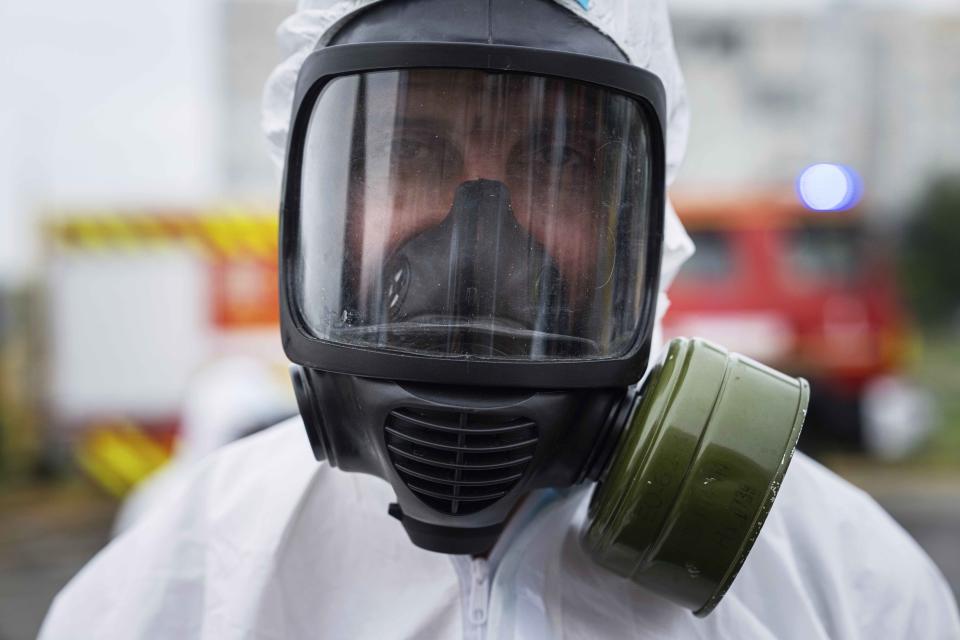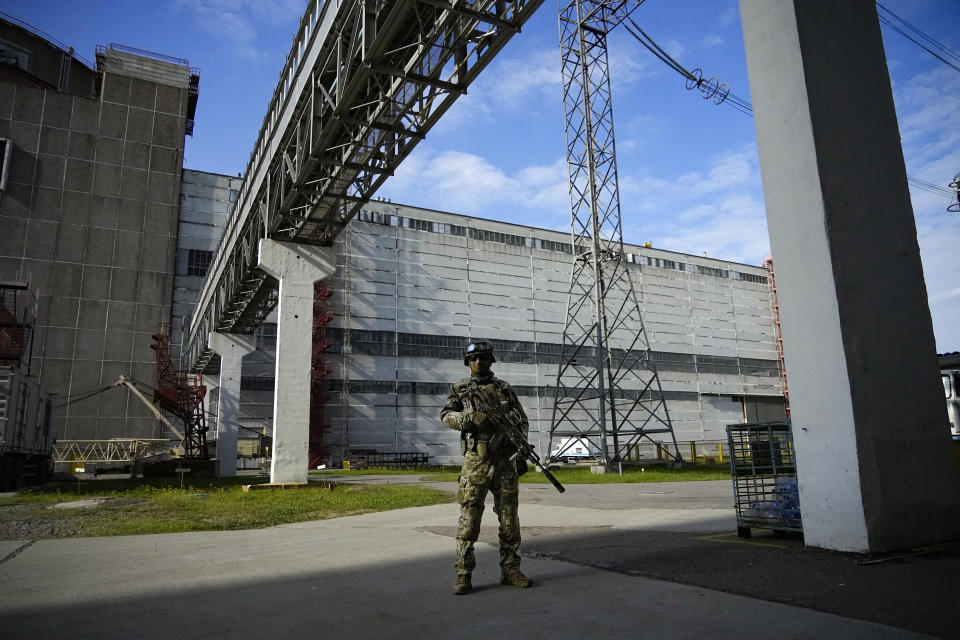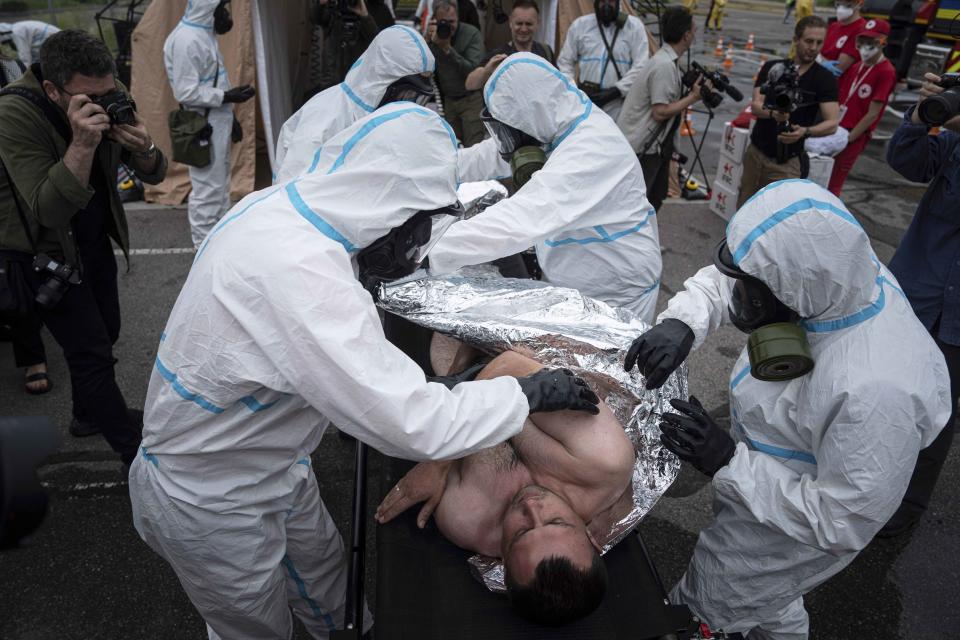Should the world be worried as Ukraine and Russia trade nuclear plant accusations?
- Oops!Something went wrong.Please try again later.
It sounds like a doomsday nightmare: Europe’s largest nuclear power plant stuck in the middle of a war zone, now allegedly wired with explosives ready to spread a radiological catastrophe across the continent.
Ukraine’s Zaporizhzhia nuclear power plant has been a constant source of dread since it was captured by Russia in March 2022 in the early days of its invasion. A drumbeat of warnings from Kyiv and Moscow has grown in recent weeks, crescendoing late Tuesday with each side accusing the other of planning an imminent attack designed to frame its warring rival.
The increasingly drastic warnings have fueled rising concern among residents in southeastern Ukraine and beyond — not least given the destruction of the huge dam that had previously been a source of similar alarm and accusations. But some experts told NBC News that the risk of a widespread radiation leak was low.
“It is actually quite difficult to arrange a significant reactive incident here,” said Pavel Podvig, a senior researcher at the United Nations Institute for Disarmament Research in Geneva. “Even if you try to blow it up, I don’t think you could spread” the radiation beyond a few hundred yards.
'New evil?'
Ukraine has warned for months that Russia might try to blow up the nuclear plant. But rarely have these warnings been as specific as President Volodymyr Zelenskyy was late Tuesday, when he said Russia had placed “objects resembling explosives” on the roof — perhaps intending to blame an attack on Ukraine.
“It is the responsibility of everyone in the world to stop it,” he said, in his latest appeal for more assistance from allies. “No one can stand aside as radiation affects everyone.”
The Kremlin has presented its own version of events.
President Vladimir Putin’s spokesman, Dmitry Peskov, said Wednesday that the Russian-controlled plant was at risk of “sabotage” by Ukraine. The deputy adviser at the Russian energy giant Rosenergoatom, Renat Karchaa, said Ukraine was planning to strike the plant with a tactical ballistic missile tipped with a nuclear waste-filled warhead, Russia's state-owned news agency RIA Novosti reported Tuesday.
NBC News has not verified the claims of either side.
The International Atomic Energy Agency has issued regular warnings about the danger of fighting around a nuclear plant. It said in a statement Wednesday that partial inspections had revealed no evidence of mines or other explosives, but that it had not been granted access to the whole site.
It added that no shelling or explosions have been reported recently and that the military presence at the site appeared unchanged.

This part of the world doesn’t need to imagine what nuclear catastrophe looks like.
Around 340 miles northwest of Zaporizhzhia, the meltdown of the Chernobyl nuclear power plant in 1986 remains the worst of its kind on record.
Some 200,000 people were evacuated, radioactive material was blown across the Northern Hemisphere, and scientists say a 19-mile exclusion zone may not be safe for 24,000 years, the half-life of the plutonium-239 released. Though officially fewer than 50 people died, the meltdown resulted in a “far higher than normal” rate of thyroid cancer among children in the area, according to the IAEA.
Comparisons are inevitable then, particularly given that Zaporizhzhia is almost twice the size of Chernobyl and finds itself in the midst of a modern land war.

Many in eastern Ukraine have felt increasing panic this week, fueled by a fervent rumor mill on the popular Telegram messaging app, which residents check throughout the night.
The country's deputy defense minister, Hanna Maliar, said Wednesday that emergency services across four regions had been doing days of extra training to cope with "a possible terrorist attack" on the plant.
These fears were hardly tempered last week when local Russian-installed government officials said they had evacuated 1,600 people, including 660 children, from the area around the plant.
The area has also already seen what happens when a colossal piece of vital infrastructure is destroyed.
Last month, farther down the Dnieper River, the Kakhovka dam burst, apparently following an explosion, flooding homes and forcing thousands of residents to flee while threatening an "ecological catastrophe."
Zelenskyy himself said the muted international reaction to this — he blames Russia but his allies have not publicly apportioned blame — “may incite the Kremlin to commit new evil.”

Most experts agree that any nuclear power plant should be off-limits in conflict. But some disagree about how bad an explosion at Zaporizhzhia would be in terms of a widespread nuclear disaster.
“If you blow up nuclear fuel, you’re going to get contamination,” said Hamish de Bretton-Gordon, the former commander of Britain's and NATO’s chemical, biological and nuclear defense forces. “You’re not going to get a nuclear explosion, but the fires potentially created could spread contamination, as happened at Chernobyl.”
Zaporizhzhia is more modern than Chernobyl, built in the early 1980s, around 10 years after construction of its infamous cousin began. And de Bretton-Gordon said its far more sturdy design, aimed at withstanding being hit by a jetliner, means the risk would come only from a blast inside the facility itself.
But other experts have said that fundamental differences between the design of two plants means that the risk of widespread radiation contamination is low regardless.

The Zaporizhzhia plant's reactors are housed inside stainless steel containment vessels, which themselves are placed inside walls of thick, reinforced concrete. Unlike Chernobyl, its design does not use graphite, the material that caught fire in the 1986 incident and spread radioactive material into the atmosphere.
Zaporizhzhia’s six reactors “are not at all like the Chernobyl reactor and cannot, CAN NOT, have the same kind of accident,” wrote Cheryl Rofer, a retired nuclear researcher who worked for more than 30 years at the Los Alamos National Laboratory, the U.S. government facility in New Mexico.
The Institute for the Study of War, a Washington-based think tank, agreed it was "unlikely that limited Russian sabotage" at Zaporizhzhia "would be able to generate a massive radiological incident."
Perhaps most crucially, all six of Zaporizhzhia’s reactors are currently in cold shutdown, meaning they are far cooler than those in Chernobyl or Fukushima, the plant that melted down following Japan’s earthquake and tsunami in 2011.
"I don't think these accusations and counteraccusations are very helpful," said Podvig, at the U.N. Institute for Disarmament Research. “The message should be that the plant should be off limits for any military action — and I would probably say for propaganda, too.”
This article was originally published on NBCNews.com

